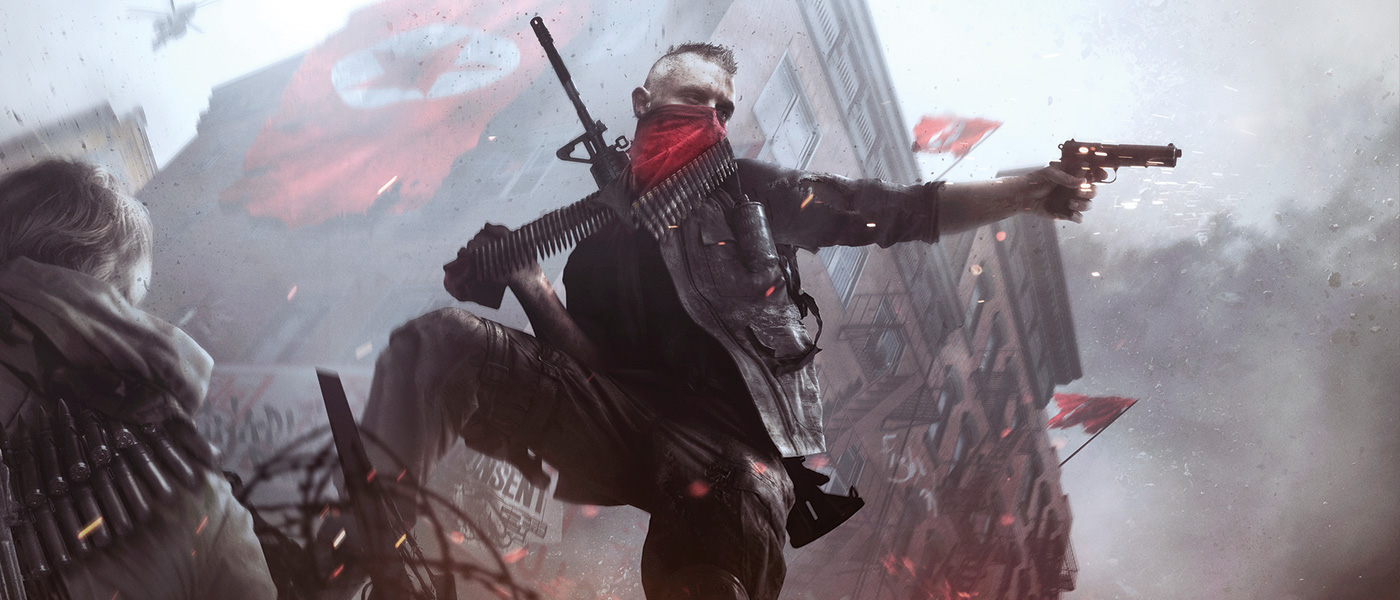 Homefront: The Revolution is set in the year 2029, four years after the North Koreans invaded the United States after remotely disabling all of the technology of opposing forces, which were supplied by the North Koreans themselves. Serving as a technological and military superpower, the North Korean government has taken over the United States completely, turning major cities into warzones and oppressing American citizens.
Homefront: The Revolution is set in the year 2029, four years after the North Koreans invaded the United States after remotely disabling all of the technology of opposing forces, which were supplied by the North Koreans themselves. Serving as a technological and military superpower, the North Korean government has taken over the United States completely, turning major cities into warzones and oppressing American citizens. The ideas/concepts behind The Revolution’s narrative are pretty interesting on paper, with the opening providing a proper introduction into the interesting world that the game attempts to set up, though some of the elements of the concept do seem to take quite a bit of suspension of disbelief. That being said, as interesting as the ideas of Homefront’s plot are, none of them really get any development and depth to truly create a coherent narrative throughout the game. The campaign is riddled with one-dimensional characters, which are accompanied by an equally subpar sense of plot progression, which ultimately leaves the game dragging its feet throughout as it stumbles to an equally disappointing finale.
The ideas/concepts behind The Revolution’s narrative are pretty interesting on paper, with the opening providing a proper introduction into the interesting world that the game attempts to set up, though some of the elements of the concept do seem to take quite a bit of suspension of disbelief. That being said, as interesting as the ideas of Homefront’s plot are, none of them really get any development and depth to truly create a coherent narrative throughout the game. The campaign is riddled with one-dimensional characters, which are accompanied by an equally subpar sense of plot progression, which ultimately leaves the game dragging its feet throughout as it stumbles to an equally disappointing finale. The Revolution’s presentation on a design-level is definitely a lot stronger than the storytelling aspect of the game, where the environments of Philladelphia are a lot more dense and varied than the story you’re being told throughout the game. There’s plenty to explore and structures don’t feel as closed off as you’d expect from an open world shooter of this scale.
The Revolution’s presentation on a design-level is definitely a lot stronger than the storytelling aspect of the game, where the environments of Philladelphia are a lot more dense and varied than the story you’re being told throughout the game. There’s plenty to explore and structures don’t feel as closed off as you’d expect from an open world shooter of this scale.
However, even though the game is well designed when it comes to the world you’re exploring, its presentation is rather lackluster. Whilst overall the game world is impressive, the smaller details and textures are rather rough to say the least. The visual fidelity takes a pretty jarring hit when you look at your surroundings in greater detail, which is rather disappointing given the fact that looking at the world you can definitely tell a lot of time went into designing it. Character models from afar seem decent, but in motion animations and details seem to take a nose-dive up close, where especially facial animations seem to vary between stiff and over-exaggerated, where there is no natural nuance to them at all, whilst general movement seems to be decently animated.
Character models from afar seem decent, but in motion animations and details seem to take a nose-dive up close, where especially facial animations seem to vary between stiff and over-exaggerated, where there is no natural nuance to them at all, whilst general movement seems to be decently animated.
That all being said, The Revolution is definitely a dissapoing product given its performance, especially considering the fact that the CryEngine seems to be completely wasted in both visual fidelity and performance, with a game that could easily look and perform better than it does given due time. Homefront: The Revolution’s base game is pretty straightforward. As you move throughout the story you fight to take back the city from your enemies, moving from district to district to complete several side-quests and main missions that involve either taking over checkpoints, destroying enemy property or clearing enemies in a certain area. These objectives pretty much return like clockwork per section of the game, where the campaign ultimately turns into a repetitive checklist that leads to a finale that is anything but satisfying.
Homefront: The Revolution’s base game is pretty straightforward. As you move throughout the story you fight to take back the city from your enemies, moving from district to district to complete several side-quests and main missions that involve either taking over checkpoints, destroying enemy property or clearing enemies in a certain area. These objectives pretty much return like clockwork per section of the game, where the campaign ultimately turns into a repetitive checklist that leads to a finale that is anything but satisfying.
Whilst I usually try to avoid comparisons with other titles during my reviews, there is no way I can talk about Homefront: The Revolution without bringing in the more recent Far Cry titles as comparable example of the gameplay base of this title. Many mechanics and large parts of the gameplay design share a lot of similarities, albeit aside from the excellent ‘Weapon Conversion’ mechanic The Revolution never really stands on its own by executing them in a successful manner. This all transcends into the performance as well, which is rather terrible to say the least. Aiming for a maximum framerate of 30 frames per second, Homefront: The Revolution rarely seems to succeed in reaching this target. mostly dipping into the mid 20’s and in more extreme cases the lower 20’s, which heavily impacts gameplay throughout.
This all transcends into the performance as well, which is rather terrible to say the least. Aiming for a maximum framerate of 30 frames per second, Homefront: The Revolution rarely seems to succeed in reaching this target. mostly dipping into the mid 20’s and in more extreme cases the lower 20’s, which heavily impacts gameplay throughout.
This issue however is bundled with an even greater problem, which is the extremely narrow field of view. The player camera often seems like it’s placed on the player’s chest, with gun models sometimes taking over up to 25% of the screen, creating a very claustrophobic experience. Having played first person shooters on consoles for the majority of my gaming career, I’ve come across a lot of shooters with limited FOV’s, but the extent of the issue in this case combined with the performance issues made Homefront: The Revolution one of my most frustrating gameplay experiences to date. Despite its underlying ambitions and some redeeming qualities, Homefront: The Revolution is a revolution in name only, though it feels more like a domestic dispute than anything of that scale. Combining subpar storytelling and gameplay with a heap of performance issues, this revolution seems to come to an end before it ever begins.
Despite its underlying ambitions and some redeeming qualities, Homefront: The Revolution is a revolution in name only, though it feels more like a domestic dispute than anything of that scale. Combining subpar storytelling and gameplay with a heap of performance issues, this revolution seems to come to an end before it ever begins.
The Xbox One version of Homefront: The Revolution was primarily tested for the purpose of this review.



